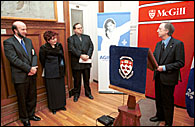Looking ahead to the past
Think about Quebec history for a moment.
Are you picturing the tanks rolling down Montreal streets during the October Crisis ? Jackie Robinson breaking baseball's colour barrier as a member of the Montreal Royals?
 Redpath Museum director Graham Bell (right) thanks Quebec Culture and Communications Minister Diane Lemieux (second from left) for the government's support of the museum.
Redpath Museum director Graham Bell (right) thanks Quebec Culture and Communications Minister Diane Lemieux (second from left) for the government's support of the museum.PHOTO: Owen Egan |
|
Think further back. Much, much further back.
"Some of the most dramatic events in Earth history have occurred in or near Quebec -- among them, the emergence of the first land plants, the first amphibians and their ancestors, and the first true land animals," says biology professor Graham Bell, the director of the Redpath Museum.
Quebec's prominent place in our efforts to understand how life developed on this planet will soon be highlighted in a permanent exhibit that is being assembled at the Redpath. The work is being supported by funding from Quebec's Ministry of Culture and Communications.
The Redpath is ideally positioned to put together such an exhibit, says Bell, because of its valuable and extensive collections of items related to early Earth history.
Much of the fossil evidence supporting some of the prehistoric milestones that will be showcased by the permanent exhibit have been uncovered and/or studied by McGill researchers.
Sir John William Dawson, a McGill principal and one of the 19th century's star scientists, was instrumental in his contributions to our understanding of the planet's first land plants. Indeed, the museum was built, in large part, to house Dawson's extensive collections.
That tradition carried on with former Redpath director Thomas Clark, who made some important discoveries in the fabled fossil-rich Joggins area of Nova Scotia. And it continues today, with the work of, among others, biology professor Robert Carroll, one of the world's most respected vertebrate paleontologists.
Bell says the permanent exhibit will draw on Carroll's expertise. Adjunct professor Hans J. Hofmann from the Department of Earth and Planetary Sciences, a leading authority on life in the Cambrian and pre-Cambrian periods (about 570 million years ago), will also be involved, as will earth and planetary sciences professor Jean Paquette, a minerals expert. The Redpath's curators Ingrid Birker (paleontology) and Joan Kaylor (geology) will play major roles as well.
Bell says the exhibit will include samples of the earliest land plants and the earliest land animals. "We'll be showing some of the oldest creatures in the world. I think this will be a real eye-opener for the general public," Bell adds, noting that not many Quebecers realize that so many monumental moments in the planet's history took place within driving distance of their homes.
"There isn't another exhibit like this in Quebec."
The exhibit will also deal with Quebec's rich geological history and with the biological diversity evident in the province today.
In all, the Redpath received $560,000 in funding from the Quebec government. Some of that money will go towards the renovations currently being done at the museum. Bell says the money will help to accelerate the pace of the renovations, especially since the grant stipulates a timeline. "I have $295,000 to spend by December 31."
The renovations address some of the ordinary wear and tear one would expect to see in a building that dates back to 1892. But some of the work is aimed at resurrecting some of the building's original charms.
Bell notes that the museum underwent extensive renovations in the 1950s and '60s -- much of it wrong-headed.
"An attempt was made to 'modernize' the museum. A lot of the original Victorian woodwork was covered up" and the end result, in Bell's estimation, was a museum that became more "cramped and dingy."
The renovations going on now aim to give the museum some of its old sparkle back. The building's unique Victorian design has led to its recognition as one of the 27 most important heritage sites in the province. Bell is pleased with the direction of the renovations. "There has been an immense improvement."

